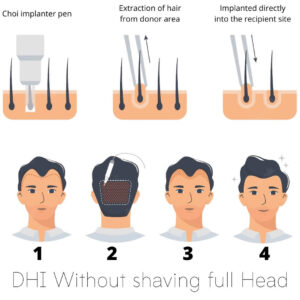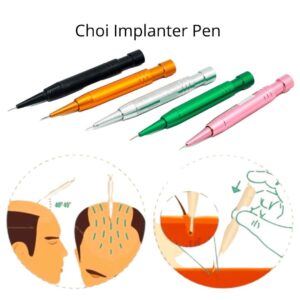- Persian: (+90 507 138 03 03). English: (+90 507 015 06 03)
DHI application, which is advised for individuals who wish to create a frequent and rich appearance as a consequence of hair transplantation, is indicated as an alternative to FUE approach. In spite of the fact that there is no visible difference between the two procedures, the instruments employed vary widely.
Differences between these two approaches, whose dependability and effectiveness have been shown by worldwide authority, include the following.
– After the blood test, the donor region to be grafted is shaved in the FUE process.
– The expense of the medical tools and the level of professionalism necessary for hair transplantation are two key differences between DHI and FUE.
– There is a clear difference between the number of grafts transplanted at once in the DHI method and the amount implanted in FUE.
– In the FUE procedure canalization prolong healing process, hence recovery may be visible in less time after the DHI application.
– One of the key distinctions between DHI and FUE procedure is the potential of frequent implanting. The thin-tipped medical equipment utilized in DHI hair transplantation makes a huge difference in the collection and positioning of grafts. This technique allows for more frequent implants and is more suited for operations in smaller spaces.
The thin-tipped gadget is used to open a channel, and the roots are transferred to it using the same pen. By this approach, two steps are accomplished at the same time without further processing. When used often and naturally, its thin end makes it a useful tool for determining direction. As a result, DHI hair transplantation is preferred over FUE when doing transplants in a small region.
Why is DHI Hair Transplantation Method preferred?
Many individuals are worried about how long it would take to heal after a hair transplant. The healing process is influenced by the application method and the care that follows. Both the price and the end outcome depend on a number of different aspects such as the size of the implanted area and the preferences and decisions you make for yourself based on those preferences.
The DHI technique effect is recognized as a sophisticated and current approach proved by professional experts. So that it is particularly advised for persons who have dilution in a restricted region. The pricey and useful choi needle used in this approach enables to canalization and root insertion operation repeatedly. Since these steps are not required, the hair transplantation procedure may be done right away. One of the reasons the approach is recommended is that it decreases the likelihood of roots becoming dysfunctional.
Another reason why DHI application is popular is that it offers the convenient circumstances for regular hair transplanting. Those who suffer from spatial disorientation should try this approach, since it yields a more natural effect. Since the thin-tipped needle facilitates side-by-side and frequent transplanting, it offers an application that is consistent with the exit direction of hair.
The innovative construction of the DHI pen provides a natural-looking outcome that is equivalent to other areas of individuals who are suffering locational loss. Another benefit of the pen is the least injury to tissue, hence the mending process takes less time. It gives a considerable convenience in crusting, inflammation and others. In addition to these, your everyday life won’t have a hitch since it enables you to undertake unshaven procedures when it is not essential. All these factors and more make the DHI approach widely recommended.
DHI Hair Transplantation Prices
The DHI hair transplantation process is administered using a costly medical pen and is known for its reliability and effectiveness. Both throughout the procedure and during the recuperation phase, it’s critical that this pen be used by professionals who have undergone thorough training. The cost of this approach may be influenced by the high level of training and experience required by the specialists. You may obtain information and find out the latest costs by contacting authorized persons.
